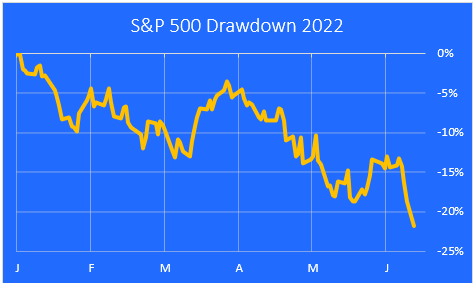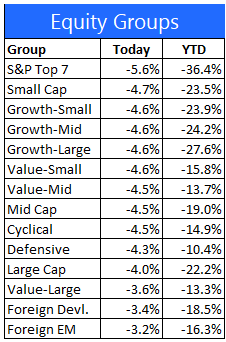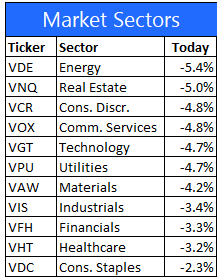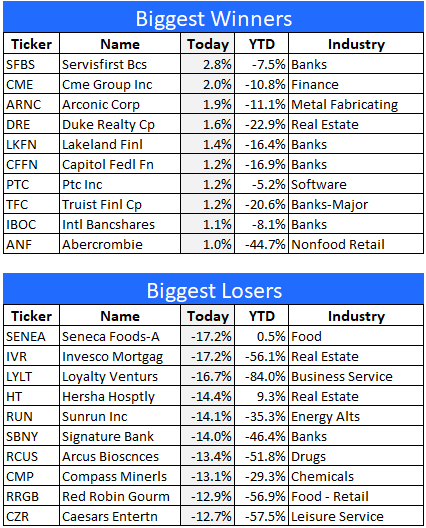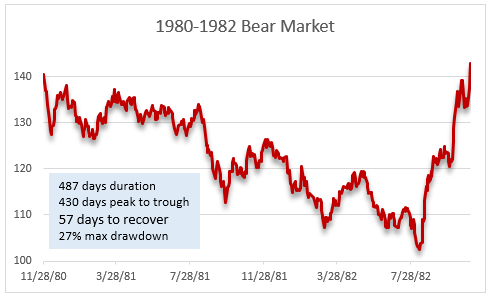The Big Flush.
The 1-Minute Market Report is tailored for those who want a quick recap of what's going on, without the usual fluff and filler. I try to focus on the main drivers of the current market action, and offer some brief commentary along the way.
A quick summary
- The S&P 500 is now officially in a bear market..
- The dip-buyers failed to defend the bear market line at 3837.
- The causes of today's rout were an inflation hangover and recession fears.
- 73% of all stocks are now down 20% or more..
- The next shoe to drop could be a 75 bp hike in the Fed Funds rate.
- Earnings estimates are too high and will have to come down.
Chart 1. Today's stats
We begin with the daily stats. Today was an exceptionally weak day, capping off an exceptionally nasty 4-day slide. Of the 1,500 stocks in the S&P 500, 400, and 600 combined, only 26 were up today. That makes today a 57-to-1 down day, which is a rare market event.
73.7% of all stocks are now in a bear market, with the median stock down by -29.4%. The decline of 3.88% in the S&P 500 makes today the 58th worst day out of 18,230 trading days since 1950. (See chart 2 below.)
Chart 2. Largest 1-day declines for the S&P 500
There is a kernel of hope in all of this. These big declines tend to happen near the end of bear markets, not at the beginning. On average, the market is up 1.82% after 3 months, up 9.62% after 6 months, and up 20.22% after 12 months following a decline of this magnitude.
Chart 3. S&P 500 Drawdowns YTD
Today the market opened slightly above the bear market line but quickly fell below it and never looked back. Rally attempts were weak and fleeting.
Chart 4. Equity Groups % Change
The next chart shows the performance of stocks that share certain characteristics, like value vs. growth, large vs. small cap, and cyclical vs, defensive. I created these groups to offer a way of visualizing the flow of investor money - where it's going and where it's coming from.
The S&P Top 7 (AAPL, MSFT, GOOGL, AMZN, TSLA, NVDA, FB) drove the market higher last year, and now they are leading the market lower.
Emerging Markets held up better than any other group.
Chart 5. Market Sectors % Change
The energy sector has been leading the market by a mile all year. Today it became a source of funds as investors scrambled to get out of the way.
The defensive Consumer Staples sector held up the best, as expected.
Charts 6 & 7. Best and worst performing stocks
The final two charts drill down into the specific stocks that gained and lost the most today. 5 of the 10 top performers are banks. The losers list is a mixed bag.
Final Thoughts
After a day like today, and a 4-day slide like we've just gone through, it's only natural to ask questions like, is this the bottom or is it the start of something much worse? Much of that depends on whether the Fed can be aggressive enough to bring inflation to heel but not so aggressive that they send us into a recession.
A recession would certainly tame inflation, but at what cost to investors, savers, and consumers? Unemployment would rise, corporate earnings would fall, and the stock market would take another hit.
When Paul Volcker became Fed chairman in 1979, inflation was about where it is now and headed even higher. He inherited a Fed Funds rate of 10%, but inflation kept rising. So, over the next several months, he raised the rate to 20% - sending the economy into not one, but two back-to-back recessions - in 1980 and again in 1981.
It is widely believed that Volcker deliberately caused the 1980 recession, although there is some debate as to whether he intended to cause the one in 1981. Regardless, he did what he did because he saw inflation as public enemy #1. Does Chairman Powell see today's inflation problem the same way? I think he does, but I don't think he's set on inducing a recession this time around. I think he's more sensitive to what's happening in the stock market than Volcker was back in the day.
The twin recessions during the Volcker era took the market down by 27% peak-to-trough and lasted about 20 months. Since we're already down 21.8%, we might be closer to the bottom than we think.
I'll leave you with a chart of the Volcker bear market.



